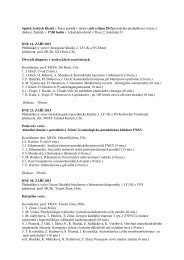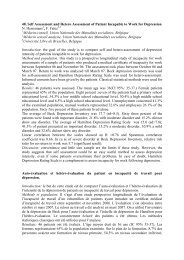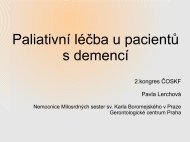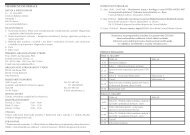ABSTRACTS â ORAL PRESENTATIONS - AMCA, spol. s r.o.
ABSTRACTS â ORAL PRESENTATIONS - AMCA, spol. s r.o.
ABSTRACTS â ORAL PRESENTATIONS - AMCA, spol. s r.o.
You also want an ePaper? Increase the reach of your titles
YUMPU automatically turns print PDFs into web optimized ePapers that Google loves.
tissues is characteristic for a number of these pathological states. Thus, chemoattractantdirected<br />
migration of mature mast cells or their progenitors might be one of the key<br />
mechanisms responsible for local accumulation of these cells under physiological or<br />
pathological conditions.<br />
Aggregation of high-affinity receptors for IgE (FcεRI), expressed in the plasma membrane<br />
of mast cells, with polyvalent antigen (Ag) leads to cell activation and release of a<br />
broad spectrum of chemical mediators. FcεRI is also involved in mast cell chemotaxis<br />
towards Ag. Mast cells express a variety of chemokine receptors which bind various<br />
chemoattractants, including stem cell factor, sphingosin-1-phosphate, and arachidonic<br />
acid metabolites as leukotriens and prostaglandins (2). Prostaglandin E 2<br />
(PGE 2<br />
) is one<br />
of the major eicosanoids generated during inflammation and potent mediator which<br />
substantially influence mast cell responses, including chemotaxis (3). PGE 2<br />
binds to<br />
E-prostanoid receptors and engage cAMP/PKA pathway (4). However, detail signaling<br />
process leading to mast cell chemotaxis mediated by PGE 2<br />
is incompletely understood.<br />
In this study we analyzed the effect of different drugs affecting cAMP/PKA signaling<br />
in PGE 2<br />
stimulated mouse bone marrow derived-mast cells (BMMCs). We focused on<br />
characterisation of cell spreading on fibronectin as well as changes in cell motility after<br />
stimulation. For analysis of these responses we introduced several quantitative imagebased<br />
cytometry techniques which facilitate large scale image acquisition and data<br />
processing. Using these and other methods we found that potentiation or blocking of<br />
cAMP/PKA signaling has signifcant effect on mast cell signaling pathways induced by<br />
PGE 2<br />
. Consequently, these signaling pathways might contribute to pathological states<br />
occuring in allergy and inflammatory diseases.<br />
Acknowledgements<br />
This work was supported by COST CZ project No. LD12073.<br />
References<br />
Galli, S. J., Tsai, M., and Piliponsky, A. M.: The development of allergic inflammation. –<br />
Nature 454: 445-454, 2008.<br />
Hálová, I., Dráberová, L., and Dráber, P.: Mast cell chemotaxis – chemoattractants and<br />
signaling pathways. - Frontiers in Immunology 3: 1-19, 2012.<br />
Kuehn, H. S., Rådinger, M., Brown, J. M., Ali, K., Vanhaesebroeck, B., Beaven, M.<br />
A., Metcalfe, D. D., and Gilfillan, A. M.: Btk-dependent Rac activation and actin<br />
rearrangement following FcεRI aggregation promotes enhanced chemotactic responses<br />
of mast cells. – Journal of Cell Science 123: 2576-2585, 2010.<br />
Serra-Pages, M., Olivera, A., Torres, R., Picado, C., de Mora, F., and Rivera, J.: E-prostanoid<br />
2 receptors dampen mast cell degranulation via cAMP/PKA-mediated suppression of<br />
IgE-dependent signaling. - Journal of Leukocyte Biology 92: 1155-1165. 2010.<br />
Legend to figure<br />
Fig. 1. Images and quantification of changes in mast cell morphology after activation<br />
with Ag or PGE 2<br />
. BMMCs were sensitized with IgE and attached to fibronectin. Cells<br />
were activated with Ag (B), PGE 2<br />
(C) or were not activated (A). After fixation and<br />
permeabilization the cells were stained with Alexa Fluor 488-phalloidin for filamentous<br />
actin (F-Actin; green) and with Hoechst stain for nuclei (blue). Images were acquired<br />
on Olympus Scan^R system and analyzed using CellProfiler image analysis software<br />
86 Analytical Cytometry VII








